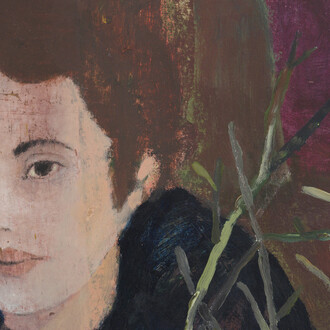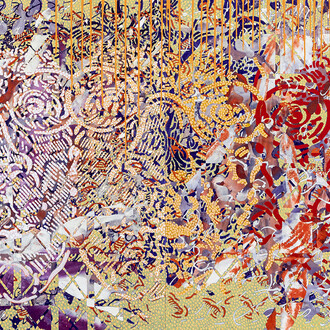The VivoEquidem Gallery is delighted to welcome Benyounès Semtati for his exhibition, "The useless as a desire for representation." Through a selection of works from 2014, the artist brings us to the world in which he exists without this "tasteless obsession of being useful."
Using recuperated cardboard with gouache, pencil or chalk, Benyounès Semtati refuses the artifice of virtuosity and the tackiness of minutely crafted art objects. He feels freer not focusing on the modus operandi, even though we do note great expertise in the "still life" of apples that painted elegantly on a market grocer's printed paper bag.
While not nihilistic, his work evokes the useless as an antidote to a type of mental or even social desertification. It can be said that not seeking relevance, effectiveness or success in all acts of life today constitutes a challenge for the individual in general, and artists in particular.
"I feel like I work to avoid suffocation. " This explains why his works are particularly airy and light. These works are dispersed among his numerous readings and multiple inner over-oxygenated perambulations. Saint Bartholomew in the Last Judgment in the Sistine Chapel reappears in his work Resurrection Dior, in which a female character from a fashion magazine is naively stylized and manicured. She looks like the saint in Michelangelo's work, just skin devoid of flesh. In Semtati's work, the judgment of bodies is performed in magazines ...
For Empire Sate Africain, the artist stacked wobbly and insecure constructions on top of each other to make inspired architecture. This collage in wood exemplifies Semtati's interest in all sorts of entanglements: intellectual, cultural, social and technical. He is not concerned about the balance of the work because it is not meant to be useful.
He has also created bold and poetic interpretations in works. For example, he created an assemblage of four small rooms, Adam et Eve. In it, a naked couple moves away holding each others' hands as they go towards the dark, the place where anything is possible. They are framed by two collages forming de-constructed faces with multiple eyes. According to the artist, this is the spirit of "young people" at this particular moment of World history. This may also be an illustration of the first neurosis. Below, another collage shows a head with a loaf of bread for a brain (made from fermenting yeast) and two pumpkins located at the eyes to evoke the eye as the source of illusion, remember Cinderella's carriage?
Semtati has become a static traveler after having traveled extensively. Benyounès Semtati does not reinvent the world. He does not seek to illustrate or decipher the world, nor to combat or denounce it. He bears witness to nothing and holds claim to nothing other than to being here. This is precisely what makes his works are so attractive, we might even say useless.
"If we can't understand the usefulness of the useless, the uselessness of the useful, we cannot understand art. A country in which one does not understand art is a country of slaves or robots, a country of unhappy people, people who neither laugh nor smile, a country without spirit, where there is no humor and no laughter. There is anger and hatred. " Ionesco, 1961.
Born in 1966 in Oujda, Morocco, Benyounès Semtati grew up in France. He was admitted to the Beaux-Arts School of Saint-Etienne, but personal choices and professional circumstances quickly lead him to Arles and Marseille, on a tour of Europe and then the United States and, finally, to Paris. As part of the group exhibition Africa Remix (2005), his works have been exhibited in Düsseldorf, London, Johannesburg, Stockholm and the Paris Centre Georges Pompidou.
Based in Montreuil for a long time, he has returned there recently after a long period in northern France.


















